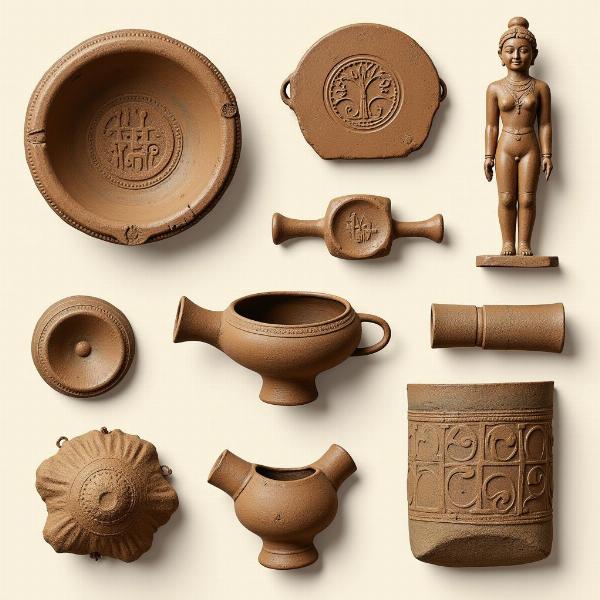The term “pragaitihasik” (प्रागैतिहासिक) in Hindi holds a captivating allure, transporting us to a time shrouded in mystery – the prehistoric era. But what exactly does “pragaitihasik meaning in hindi” encompass? This article delves into the rich meaning of this word, exploring its significance in understanding India’s ancient past and its connection to global prehistory.
Decoding “Pragaitihasik”: A Journey into the Past
“Pragaitihasik” is a composite word derived from “praag” (प्राग), meaning “before” or “prior to,” and “aitihasik” (ऐतिहासिक), meaning “historical.” Thus, “pragaitihasik” literally translates to “pre-historical” or “belonging to the period before recorded history.” This period, spanning millennia, encompasses the vast stretch of time before the advent of writing systems, leaving us to decipher the past through archaeological discoveries and anthropological studies.
Exploring India’s Pragaitihasik Landscape
India boasts a rich and diverse prehistoric heritage. From the Paleolithic era, with its evidence of early hominids, to the Neolithic period marked by the development of agriculture and settled communities, the Indian subcontinent offers a treasure trove of prehistoric sites. These sites, scattered across the country, provide glimpses into the lives of our ancestors, their tools, their art, and their understanding of the world.
Pragaitihasik Art and Culture: Echoes of the Past
The prehistoric period, while lacking written records, speaks to us through its art and artifacts. Rock paintings, found in caves across India, offer valuable insights into the daily lives, beliefs, and artistic expressions of prehistoric communities. Similarly, the tools and weapons discovered at archaeological sites reveal the technological advancements and survival strategies employed by our ancestors.
The Significance of “Pragaitihasik” Studies
Understanding the “pragaitihasik” period is crucial for comprehending the trajectory of human evolution and the development of civilizations. It provides a foundation for understanding the cultural, social, and technological advancements that shaped the world we live in today. Furthermore, the study of prehistory helps us appreciate the interconnectedness of human societies across time and space.
The Ongoing Quest: Unraveling the Mysteries of Prehistory
While much has been learned about India’s “pragaitihasik” past, many mysteries remain. Archaeological excavations and ongoing research continue to unearth new discoveries, adding to our understanding of this fascinating era. The quest to unravel the secrets of the prehistoric past is a testament to human curiosity and our desire to connect with our roots.
FAQ: Delving Deeper into “Pragaitihasik”
-
What is the time period considered “pragaitihasik” in India? The prehistoric period in India spans from the earliest evidence of human presence to the development of writing systems, roughly around the 3rd millennium BCE.
-
What are some important “pragaitihasik” sites in India? Some significant sites include Bhimbetka, Mehrgarh, and the Indus Valley Civilization (early phases).
-
How do we learn about “pragaitihasik” people if there are no written records? We rely on archaeological evidence like tools, pottery, fossils, and rock art, along with anthropological studies.
-
Why is it important to study the “pragaitihasik” period? Studying prehistory provides insights into human origins, cultural evolution, and the development of civilizations.
-
What are some of the key characteristics of the “pragaitihasik” period in India? Key characteristics include the development of stone tools, the transition from hunting-gathering to agriculture, and the emergence of settled communities.
-
What are the main divisions of the “pragaitihasik” era? The prehistoric era is generally divided into the Paleolithic, Mesolithic, and Neolithic periods, based on technological and cultural advancements.
-
How does the study of “pragaitihasik” India contribute to our understanding of global prehistory? It helps us understand the migration patterns, cultural exchanges, and shared human experiences across different regions of the world during prehistoric times.
 Indus Valley Civilization Artifacts
Indus Valley Civilization Artifacts
Meaning-Hindi.in offers expert translation services specializing in various fields, including business, legal, technical, website localization, educational, and specialized content. Our team ensures accurate and culturally sensitive translations, bridging language barriers and fostering effective communication. Whether you need document translation, website localization, or interpretation services, Meaning-Hindi.in is your trusted language partner. Contact us today for your translation needs at [email protected] or call us at +91 11-4502-7584. Meaning-Hindi.in – Your gateway to understanding languages and cultures.